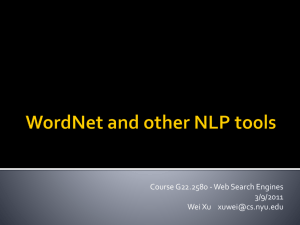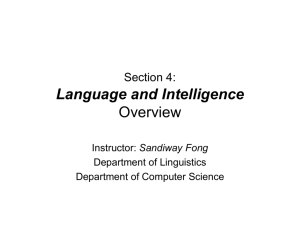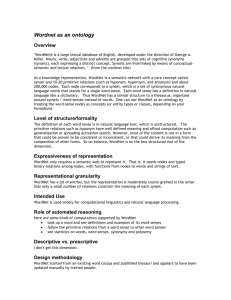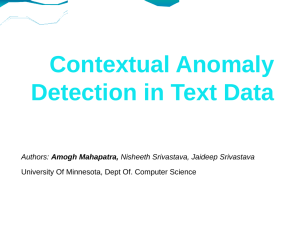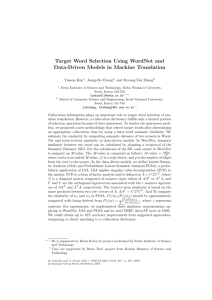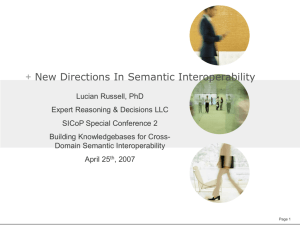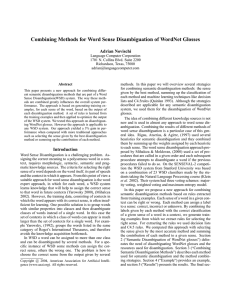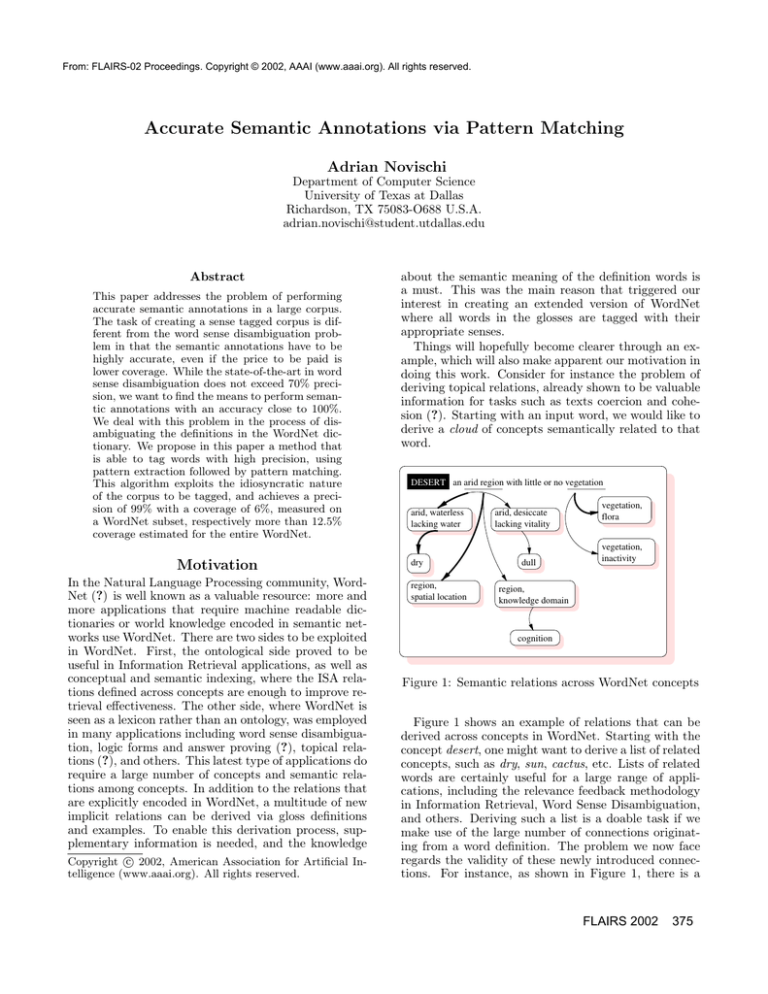
From: FLAIRS-02 Proceedings. Copyright © 2002, AAAI (www.aaai.org). All rights reserved.
Accurate Semantic Annotations via Pattern Matching
Adrian Novischi
Department of Computer Science
University of Texas at Dallas
Richardson, TX 75083-O688 U.S.A.
adrian.novischi@student.utdallas.edu
Abstract
This paper addresses the problem of performing
accurate semantic annotations in a large corpus.
The task of creating a sense tagged corpus is different from the word sense disambiguation problem in that the semantic annotations have to be
highly accurate, even if the price to be paid is
lower coverage. While the state-of-the-art in word
sense disambiguation does not exceed 70% precision, we want to find the means to perform semantic annotations with an accuracy close to 100%.
We deal with this problem in the process of disambiguating the definitions in the WordNet dictionary. We propose in this paper a method that
is able to tag words with high precision, using
pattern extraction followed by pattern matching.
This algorithm exploits the idiosyncratic nature
of the corpus to be tagged, and achieves a precision of 99% with a coverage of 6%, measured on
a WordNet subset, respectively more than 12.5%
coverage estimated for the entire WordNet.
Motivation
In the Natural Language Processing community, WordNet (?) is well known as a valuable resource: more and
more applications that require machine readable dictionaries or world knowledge encoded in semantic networks use WordNet. There are two sides to be exploited
in WordNet. First, the ontological side proved to be
useful in Information Retrieval applications, as well as
conceptual and semantic indexing, where the ISA relations defined across concepts are enough to improve retrieval effectiveness. The other side, where WordNet is
seen as a lexicon rather than an ontology, was employed
in many applications including word sense disambiguation, logic forms and answer proving (?), topical relations (?), and others. This latest type of applications do
require a large number of concepts and semantic relations among concepts. In addition to the relations that
are explicitly encoded in WordNet, a multitude of new
implicit relations can be derived via gloss definitions
and examples. To enable this derivation process, supplementary information is needed, and the knowledge
c 2002, American Association for Artificial InCopyright telligence (www.aaai.org). All rights reserved.
about the semantic meaning of the definition words is
a must. This was the main reason that triggered our
interest in creating an extended version of WordNet
where all words in the glosses are tagged with their
appropriate senses.
Things will hopefully become clearer through an example, which will also make apparent our motivation in
doing this work. Consider for instance the problem of
deriving topical relations, already shown to be valuable
information for tasks such as texts coercion and cohesion (?). Starting with an input word, we would like to
derive a cloud of concepts semantically related to that
word.
DESERT an arid region with little or no vegetation
arid, waterless
lacking water
dry
region,
spatial location
arid, desiccate
lacking vitality
dull
vegetation,
flora
vegetation,
inactivity
region,
knowledge domain
cognition
Figure 1: Semantic relations across WordNet concepts
Figure 1 shows an example of relations that can be
derived across concepts in WordNet. Starting with the
concept desert, one might want to derive a list of related
concepts, such as dry, sun, cactus, etc. Lists of related
words are certainly useful for a large range of applications, including the relevance feedback methodology
in Information Retrieval, Word Sense Disambiguation,
and others. Deriving such a list is a doable task if we
make use of the large number of connections originating from a word definition. The problem we now face
regards the validity of these newly introduced connections. For instance, as shown in Figure 1, there is a
FLAIRS 2002
375
multitude of concepts that may be easily derived by
simply following gloss connections. Unfortunately, not
all such connections are valid. We do not want to add
knowledge domain or dull to the context of desert, instead arid and dry constitute informative concepts for
this domain. Out of all possible connections that can be
set via gloss relations we want to keep only those that
are represented in bold. Having the capacity to make
the appropriate choice in selecting valid links, implies
in the first place knowledge about the meaning of definition words. If the senses of arid, region and vegetation
are known in the input gloss, we expect to have only the
bold relations set across concepts, and avoid incorrect
word associations.
terminology
Synset S = the basic unit in WordNet
= SYNonym SET = set of synonym words
Gloss G = the definition associated with a synset
Word W = the word disambiguated by a procedure
Procedure 1. Monosemous words. ID: MONOS
Identify words W with only one sense in WordNet
Procedure 2. Same hierarchy relation. ID: HYPER
Identify words W belonging to the same hierarchy as
the synset S of the gloss.
Procedure 3. Lexical parallelism relation. ID: LEXPAR
Identify words W involved in a lexical parallelism
(words connected with conjunctions or comma). These
words should belong to the same hierarchy, and
therefore they can be disambiguated.
Procedure 4. SemCor bigrams. ID: SEMCOR
Get contextual clues regarding the usage of a word
form W, based on SemCor (a corpus tagged with
WordNet senses). For now, we only rely on
SemCor bigrams.
Procedure 5. Cross reference. ID: CROSSR
For a word W ambiguous in the gloss G belonging
to the synset S, find if there is a reference
from one of the senses of the word W to the words
in the synset S.
Procedure 6. Reversed cross reference. ID: RCROSSR
For a word W ambiguous in the gloss G, find if
there is a reference from G to a word in one of
the synsets of W.
Procedure 7. Distance between glosses. ID: GDIST
Given a word W ambiguous in the gloss G, find the
number of common words between the glosses attached
to each of W senses and the gloss G.
Table 1: Best performing methods for the semantic annotation of WordNet glosses
We have to solve therefore the task of annotating
words in glosses with their appropriate sense in WordNet. WordNet 1.7 contains almost 110,000 glosses,
adding up to about 3,5 million words. From these, more
than 500,000 are open class words and will be undergoing the disambiguation process, which is far by being a
376
FLAIRS 2002
doable task without means for automatization.
The difficulty of the task turns out to be tremendously higher than simple word sense disambiguation,
as the conditions posed are for very high accuracy. The
state-of-the-art in word sense disambiguation with respect to WordNet is slightly under 70% (see the Senseval web page http://www.sle.sharp.co.uk/senseval2/),
which is far from the constraint we have in this project
of close to 100% accuracy.
Several methods have been previously proposed for
the semantic disambiguation of gloss words (?). Table 1
summarizes the best performing methods implemented
so far. They attain an overall coverage of 60% with a
precision of over 95%. We introduce in this paper an
additional method that exploits the idiosyncrasy of the
corpus formed with the entire set of definitions. The
algorithm consists in searching patterns in the corpus,
manually disambiguate them and then perform pattern
matching for improved coverage and high precision.
It was noticed that glosses have certain characteristics that could eventually help towards disambiguation.
With the method we propose here, we want to first find
these specific features and then exploit them during the
process of automatically solving semantic ambiguity.
To better explain the type of features we are looking
for, let us take a closer look at some examples of WordNet definitions. Table 2 lists eight glosses drawn from
WordNet 1.7 databases. It turns out that many lexical patterns are used in the definitions, and learning
what these patterns are will result in a tool for performing disambiguation. For instance, if we once disambiguate the pattern to a ... degree, there is no need
to repeat the same process a second time. Whenever
we encounter this pattern in a new ambiguous gloss, we
can assign the same sense as it was done for the first
time. This pattern occurs 90 times in the WordNet
database. The other three patterns observed in Table
2 have even higher frequencies: in a ... manner (1160),
the act of (1138), of or relating to (1674).
Word
highly, extremely
widely
singularly
possessively
arrival
incursion
egoistic
graduate,
Definition
to a high degree or extent
to a great degree
in a singular manner or
to a singular degree
in a possessive manner
the act of arriving at a certain place
the act of entering some territory
of or relating to the self
of or relating to studies
Table 2: Examples of WordNet glosses
Semantic annotations based on patterns
There are two distinct phases in the process of performing semantic annotations using patterns. First, we
need to extract valid patterns from the target corpus.
Target corpus
Apply algorithm
for pattern extraction
Apply algorithm
for pattern matching
Filtering
enable?
Filter patterns
PATTERN MATCHING
Pattern
unification
enabled?
Tokenization
APPLY OTHER METHODS
FOR SEMANTIC
ANNOTATION
Unify patterns
Part of speech
tagging
PREPROCESSING
Set of patterns
PATTERN EXTRACTION
Semantic annotated
corpus
Figure 2: Semantic annotations using pattern matching
The issue that we have to address here is what type of
patterns to look for and how to filter our meaningless
patterns. During this stage we also face the problem of
unification: overlapping patterns have to be unified to
their most general format.
The second stage deals with pattern matching. The
set of patterns extracted during the first step, after
being semantically disambiguated, are applied on the
original corpus. As stated earlier, the pattern based
annotation process aims at exploiting the idiosyncratic
nature of a corpus, and therefore both pattern extraction and pattern matching are performed on the same
target corpus. In our case, the corpus is formed with
all dictionary definitions found in WordNet.
Figure 2 shows the main steps performed in pattern
extraction and pattern matching. We start with a raw
corpus and end up with semantically annotated text.
Even though we use this procedure to solve the semantic ambiguity of words in WordNet definitions, the algorithm is applicable to other types of corpora.
Three main steps are identified in this figure: (1)
preprocessing; (2) pattern extraction and (3) pattern
matching. We detail below each of these steps and
present the algorithms for pattern extraction and pattern matching.
Step 1: Preprocessing
This is just a preparation step, which merely changes
the corpus into a format suitable for the stages that follow. First, definitions are extracted from the WordNet
databases. This results in four separate files, one for
each open class part of speech. Subsequently, the text
is tokenized and part of speech tagged (?).
Step 2: Pattern extraction
The decision of what rules to employ during pattern extraction has strong impact on the quality and quantity
of extracted patterns. More patterns we extract in this
step, the higher coverage they will ensure in the matching phase. Therefore, quantity directly affects the recall
of our method. On the other hand, wrong patterns will
result in wrong semantic annotations. Hence, patterns
quality is the principal factor influencing precision.
The following rules currently constitute our pattern
extraction guidelines.
Rule 1. Extract all N successive words, with N ∈ [2−5].
The rationale behind this rule is the fact that in many
cases strings of consecutive words place a constraint
over the possible word meanings. For instance, the verb
to relate will most probably have the same sense in all
occurrences of the string of or relating to. We refer
to the type of patterns extracted with this first rule as
N-patterns.
FLAIRS 2002
377
Rule 2. Extract all sequences of words that follow the
pattern “[N words] ... [M words]”. The following constraints have to be satisfied for a pattern to be extracted:
◦ N ∈ [1 − 5] ∨ M ∈ [1 − 5].
◦ The distance between the two sides, represented with
“...” includes no more than T tokens, with T=7.
◦ At least one open class word is included in each such
pattern. The purpose of this condition is to avoid patterns such as to the, of a, etc., which bring no useful
information for our task.
With these rules, we extract all possible patterns
from the entire corpus formed with WordNet definitions. Next, the patterns are sorted based on their frequency and we keep only those with a number of occurrences larger than a given threshold. Different threshold
values were considered during our experiments, and we
show in the following section the figures attained for
each such value.
To determine the values for the M and N parameters, we count all tokens found in a string, except those
marked with the tags in a stop-tag list. Currently, the
stop-tag list consists of all punctuation signs; additionally, the following parts of speech are not considered:
CC, DT, FW, LS, SYM, UH1 . This means that for instance the string and/CC today/NN has associated a
value of N=1, because we do not count and/CC towards the final value of N. This additional constraint
is intended to avoid the extraction of meaningless patterns.
Moreover, two other optional procedures can be
activated during the pattern extraction stage, as shown
in Figure 2.
Filtering can be applied to filter out meaningless
patterns. For instance, we have observed that M-N
patterns including an adjective as the only open class
word are usually not useful. We have determined so
far twelve general filters that can be applied to avoid
inutile patterns:
1. M-N patterns containing only adjectives.
2. M-N patterns containing only adverbs.
3. All patterns with an un-closed parenthesis.
4. M-N patterns containing only the word ”that” at
one side.
5. N successive words patterns that ends with ”that”.
6. M-N patterns containing only a conjunction at one
side.
7. M-N patterns containing only the preposition ”to”
at the right side.
8. M-N patterns containing only the preposition ”of”
at one side.
9. M-N patterns containing only an article (”/DT”) at
the right side.
1
They correspond to conjunctions, determiners, interjections, symbols. See Treebank tagging for details regarding
part of speech notations.
378
FLAIRS 2002
10. N successive words patterns of the form ”to [verb]”.
11. M-N patterns with a punctuation at one side.
12. M-N patterns that have only a modal verb or ”to
be” verb at the right side (”can”, ”is”, ”are”).
Unification is a step designated to combine together
similar patterns to their most general format. For instance, the following patterns:
relating ... characteristic,
relating to ... or characteristic,
relating ... characteristic of,
relating to ... characteristic of,
relating to ... or characteristic of,
can be all unified to one general pattern relating ...
characteristic. There is a tradeoff between unification
and pattern disambiguation. Sometimes the open class
words of the most general pattern does not have the
same sense in all occurences of the pattern. Therefore
in this case we should consider a more specific pattern.
Step 3: Pattern matching
The following algorithm is applied to perform pattern
matching.
1. Read in a gloss.
2. For each word W ambiguous in the gloss:
2.1. Find if there is any pattern containing word W.
2.2. From all patterns containing the word W, select
only those that are applicable on the current gloss.
2.3. If there is more than one pattern applicable:
2.3.1. Give priority to N-patterns.
2.3.2. Give priority to longest patterns.
2.4. Assign to W the sense found in the pattern.
Example. Consider for instance the definition of the
verb come close, which is “nearly do something”. The
verb do in this gloss is retrieved in the pattern do/VB/2
something/NN/1 and therefore we solve its semantic
ambiguity based on this match and assign a sense to
both words do and something.
Application on data sets
We have evaluated our pattern extraction and matching algorithms on two sets of glosses and on the entire Wordnet. The first set of glosses came from one
of the WordNet hierarchies, namely verb.social, with
1057 verb synsets. The second set of glosses came from
noun.artifact hierarchy with 3000 noun synsets. Wordnet contains almost 110,000 synsets.
In step 1, all glosses from each data set are tokenized
and part of speech tagged. Next, we extract patterns
following the two rules described in the previous section.
We decided that the patterns threshold for number of
occurences to be three i.e. to keep the patterns which
occur at least three times in a data set. This process
results in 357 patterns occurring in the verb.social hierarchy, 6461 patterns in noun.artifact hierarchy and
531,245 patterns on Wordnet. These patterns were
sorted in a descendant order of their frequencies.
We applied unification and filtering to the extracted
patterns and the number of patterns that must be analyzed and disambiguated was significantly reduced.
From the remaining patterns we have manually disambiguated 68 patterns from verb.social hierarchy, 145
patterns from noun.artifact hierarchy, and 131 patterns
from Wordnet. Table 3 lists the top ten extracted patterns from Wordnet.
Pattern
relating/VBG/2 to/TO
genus/NN/2 of/IN
in/IN ... manner/NN/1
the/DT act/NN/2 of/IN
used/VBN/1 in/IN
consisting/VBG/2 of/IN
used/VBN/1 to/TO
having/VBG ... flowers/NNS/2
used/VBN/1 as/IN
of/IN the/DT genus/NN/2
Freq.
2415
1925
1774
1137
1103
1101
1045
782
752
752
verb.social
noun.artifact
Wordnet
Number of
glosses
Number of
extracted
patterns
1057
3000
109,377
357
6461
531,245
After
unification
After
unification
and filtering
Number of
disambiguated
patterns
Number of words
that can be
disambiguated
Number of
words
disambiguated
Coverage
Precision
233
2908
134,183
150
1285
74,867
68
145
131
3979
18831
560871
242
1635
37243
6%
99%
8.6%
98%
6.6%
98%
Table 4: Pattern matching and pattern extraction
Table 3: Top ten patterns extracted from Wordnet
Acknowledgement
These manually disambiguated patterns were applied
back to the corresponding data sets and and we got
6% coverage for verb.social hierarchy, 8.6% coverage
for noun.artifact hierarchy and 6.6% on Wordnet. We
have evaluated the disambiguation accuracy for all the
words from verb.social and nount.artifact hierarchy and
for 1000 ramdom disambiguated words from Wordnet.
A precision of 98% or 99% was observed in each case.
We consider this result to be encouraging. Our task is
to perform extremely accurate semantic annotation of
gloss words, and therefore every single word that is disambiguated with high precision is highly praised. Table 4 presents various results for the pattern extraction
and pattern matching algoritms.
Conclusions and future work
This paper relates to a project that is in progress. The
task of automatically labeling gloss words with semantic
tags is very difficult, given the high accuracy required
in this project.
We have presented an algorithm that does automatic
pattern extraction and pattern matching with the purpose of performing semantic annotations. This algorithm exploits the idiosyncratic nature of the corpus to
be tagged, and succeeds in identifying repetitive expressions encountered in text. Experiments performed on
a two data sets and the entire WordNet resulted in semantic annotations that cover 6.6% of the words with a
precision of 98%, proving the validity of the approach.
This work was supported by the NSF Grant EIA0078854. The author is indebted to Rada Mihalcea and
Dan Moldovan for their collaboration and guidance on
this work.
References
Brill, E. 1995. Transformation-based error driven
learning and natural language processing: A case
study in part-of-speech tagging. Computational Linguistics 21(4):543–566.
Harabagiu, S., and Moldovan, D. 1998. Knowledge
Processing on an Extended WordNet. The MIT Press.
289–405.
Mihalcea, R., and Moldovan, D. 2001. eXtended
WordNet: progress report. In NAACL 2001 Workshop on WordNet and Other Lexical Resources: applications, extensions and customizations, 95–100.
Miller, G. 1995. Wordnet: A lexical database. Communication of the ACM 38(11):39–41.
Moldovan, D., and Rus, V. 2001. Logic form transformations of WordNet and its applicability to Question
Answering. In Proceedings of the 39th Annual Meeting of the Association for Computational Lingusitics
(ACL-2001), 394–401.
FLAIRS 2002
379



